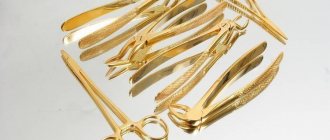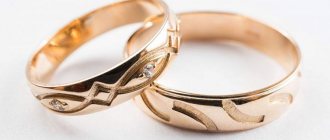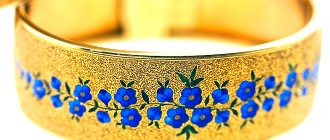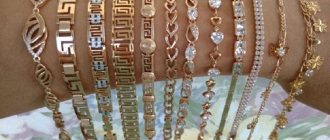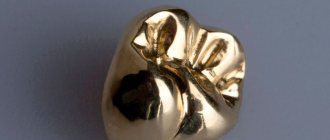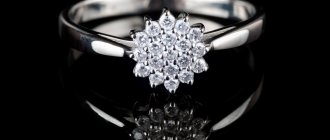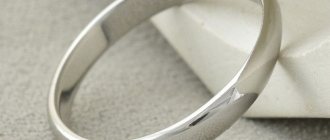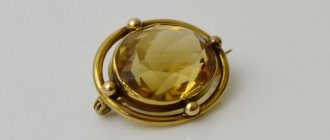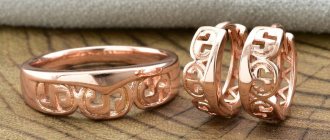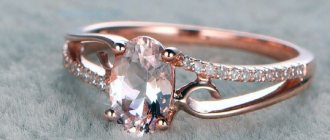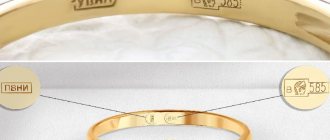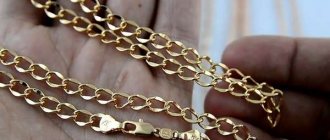What is Dubai gold really, what standard is it and how much does it cost + customer reviews
For many people, especially in the East, owning gold jewelry is an indicator of success and high income.
It is important for women to have a lot of jewelry to match different outfits. Dubai gold helps you look impressive, bright and rich for relatively little money. This is expensive jewelry that skillfully imitates real precious metal. A high-quality alloy is practically no different from high-grade gold. And the range from Dubai craftsmen is so wide that everyone will find a suitable product for themselves. I will tell you about what kind of jewelry this is, why it is popular, where to buy and how to store jewelry.
What kind of gold is this
The products are made from a special alloy, which includes brass, copper and randol (beryllium bronze). These materials themselves are not cheap. They are used to make luxury jewelry that looks like it is made of real gold.
The alloy is environmentally friendly and safe for allergy sufferers, does not irritate the skin. The structure and color of the material do not change during wear. It is resistant to corrosion, exposure to sunlight, and sea water. The jewelry will not fade over time like regular jewelry. At the same time, they can successfully replace jewelry.
Origin
Production of Dubai gold began in the United Arab Emirates. Gold jewelry in Arab countries is typically made from 18k gold, which is metric 750 gold. This is a high-grade alloy. Due to the high gold content, it has a bright, rich yellow color.
Expert opinion
Vsevolod Kozlovsky
6 years in jewelry making. Knows everything about samples and can identify a fake in 12 seconds
The jewelry alloy closely matches the shades of 18K Arabic gold. It was invented as an alternative to the real thing.
Composition and properties
The alloy simulating precious metal consists of copper, brass, randoll and a small amount of gold. A combination of copper, zinc, beryllium and tin is also used. The materials are hypoallergenic; even allergy sufferers can wear such jewelry. It will not cause negative reactions in the body.
In addition to its attractive appearance, gold from Dubai has the following properties:
- not afraid of corrosion and oxidation;
- durable;
- does not fade from salty sea water or sunlight;
- has an affordable price;
- environmentally friendly (contains no synthesized chemicals);
- has a long service life;
- durable, resistant to deformation;
- Suitable for everyday wear.
Strength and weight
The combination of components in the alloy makes it both ductile and durable. The products are resistant to shock, deformation, and scratches.
The service life of Dubai gold, subject to daily wear, is at least 3 years. The decoration will last many times longer if it is carefully stored and protected from mechanical stress.
Shade range
Jewelry made from Dubai gold can have the following colors:
- white with a blue or green tint;
- citric;
- white and gold;
- pink;
- rich yellow;
- pronounced golden.
The color depends on the composition of the alloy. The shade is also influenced by the proportions of the components.
Samples
To say that the Dubai precious metal corresponds to any standard would be wrong and incorrect. Still, fineness is a term applied to precious metals. It characterizes how many shares of gold or other precious metal are contained in a unit of the alloy.
Expert opinion
Vsevolod Kozlovsky
6 years in jewelry making. Knows everything about samples and can identify a fake in 12 seconds
In Arab countries, low-quality products are unpopular. Most of the jewelry from jewelry companies in the UAE are 14 or 18 carats (585 and 750 metric). The colors of these samples correspond in appearance to gold from Dubai.
Filled gold or goldfield - what is it and how is it better than gilding?
As you know, pure gold is a very soft and fragile material. In order for jewelry to retain its appearance and shape for a long time, more durable alloys of gold (solid gold) with other metals (silver, copper, zinc and others) are used. Their gold content is measured in carats. The most commonly used gold is 10, 12, 14 and 18 karat.
The higher the karat number, the higher the percentage of gold content in your gold jewelry.
- 24K gold is pure gold.
- 18K gold contains 18 parts gold and 6 parts one or more additional metals, which is 75% gold. 18K gold corresponds to 750 purity (75% gold)
- 14K gold contains 14 parts gold and 10 parts one or more additional metals, corresponding to 58.3(5)% gold. 14K gold corresponds to 585-583 purity
- 12K gold contains 12 parts gold and 12 parts one or more additional metals, which is 50% gold.
- 10K gold contains 10 parts gold and 14 parts one or more additional metals, which is 41.7% gold. 10K gold corresponds to 417 purity. The 10K value is the minimum number of carats that a metal must contain to be called “gold” in the United States.
Recently, gilded (gold-plated) fittings (meaning various metal parts: beads, locks, fasteners, etc.), coated with gold only from the surface, are increasingly used in jewelry and costume jewelry. This makes them much cheaper while still maintaining the appearance of gold jewelry.
Depending on the coating method, such products are divided into the following groups:
- gold plated (gold plated/gold washed/gold finished)
- filled with gold (gold filled)
The most common type of gilding is electroplating (Gold Plated or GP), i.e. electroplating with a thin layer of gold several microns thick, i.e. strictly speaking - spraying. This coating is weakly attached to the base metal (most often it is brass, copper, sometimes silver), is fragile and short-lived. The minimum gold content for such coatings is not regulated by standards, although some particularly conscientious manufacturers strive to coat their products in several layers. Fittings with galvanic coating are designated by the English abbreviation GP (Gold plated) or GEP (Gold electroplated).
Jewelry created using galvanic gold-plated fittings belongs to the costume jewelry category, i.e. “costume” jewelry, which is not recommended to be worn on the body, but only on clothes, because the “hellish” mixture of human sweat and perfume can do what even the strongest chemical reagents are unable to do - quickly ruin even the most durable accessories!
A more expensive and high-quality method of gold plating, used in the creation of jewelry and costume jewelry of a higher category (fine jewelry), is a method that, literally translated, sounds like “filled with gold” (Gold Filled or GF). The "gold filling" method consists of creating a gold layer by rolling, rapidly heating together with a base metal substrate (usually brass or copper is used as the base metal, but can also be bronze, nickel or alloys) in an airless environment to a temperature of approximately 900 degrees, and compression under high hydraulic pressure (approximately 170 atmospheres). The result is a gold coating with a thickness of 8-10 to hundreds of microns, forming a metallurgically alloyed compound with the substrate.
Gold-filled fittings are hypoallergenic, more durable than Gold plated and retain their appearance for decades, so purchasing jewelry with such fittings is a fairly reasonable investment. In other words, this is a more economical way to join the world of luxury!
Where is it used?
The alloy is most often used to make voluminous, bright jewelry. It can be made in a restrained, elegant style or, on the contrary, richly decorated in traditional oriental fashion. The material is quite soft and pliable. It is used with equal success in manual work and for the production of stamped products.
Jewelry is in great demand among the local population and tourists. This explains the variety of jewelry offered for both women and men. Precious and semi-precious stones are even inserted into jewelry.
The alloy is widely used in the souvenir industry. You can find figurines, amulets, swimsuits and even pacifiers for babies made of Dubai gold.
How is it different from regular gold?
It is almost impossible to recognize with the naked eye where is Dubai gold and where is ordinary gold. It has the same color, shine, and shines in the sun. All these characteristics correspond to high-grade gold. Even the weight of the alloy and gold in products of the same type will be approximately the same.
The alloy has slight differences in shade from gold 375, 500, 585. Gold jewelry that is familiar to us has a reddish tint due to the inclusion of copper in the composition of the alloy. The main difference between a jewelry alloy and a gold alloy is its affordable cost.
Assortment of products and decorations
The selection of items made from Dubai gold is truly huge. This is an expensive alloy. It is used in two ways - making jewelry and souvenirs. Even the most fastidious fashionista will find a piece of jewelry to suit her taste:
- earrings;
- chains with unique weaving;
- bracelets;
- rings;
- necklaces with semi-precious stones;
- pendants with various symbols.
Souvenir products are also varied. Local craftsmen make decorative items, coins, ingots, figurines, vases, amulets, and cutlery.
Advantages and disadvantages
Rich people also wear luxury jewelry from Dubai. It equally replaces jewelry in everyday wear and allows you to complement your look without large material costs. The structure and color of the material do not change over time, unlike cheap jewelry. The alloy components are resistant to corrosion, oxidation, and aggressive environmental influences. There is even a guarantee from the manufacturer that the original appearance of the jewelry will be preserved - at least 2-3 years.
The advantage of Dubai gold is its environmental friendliness and hypoallergenicity. This is probably the only jewelry that is ideal for allergy sufferers. These products are easy and safe to store at home. Another plus when buying Dubai gold is its price. This jewelry is not cheap, but much more affordable than jewelry.
The only drawback is that it is still not gold. In case of urgent need for money, jewelry cannot be pledged to a pawnshop or sold.
About prices and quality
Currently, a gram of 18-karat gold costs about 45-47 dollars (note that the figures are very approximate). The price per gram changes daily, or even several times a day. But it is the same for all stores. Every year these numbers are only growing. Initially, there is no price on the jewelry at all, or the price tag indicates a greatly inflated amount. And only skillful bargaining can reduce the cost to real indicators. Most often, the discount is 30-35%; larger discounts are offered much less frequently and very reluctantly. Buying several items at once increases the chances of getting the coveted gold at the lowest price. Do not use the services of escorts who will vying with each other to offer to take you to the best store. They do not work for thanks, so the cost of a purchase with the participation of such persons will be slightly higher than what it would have been without their participation.
Jewelry with precious stones or stones alone are also offered in abundance.
For example, the Pure Gold chain of stores, specializing in diamonds, is very good. They have both large stores and small kiosks (in almost every major shopping center in the UAE), in which the prices for products are very affordable.
The jewelry company LifeStyle will also please you with its price-design ratio. All products with diamonds or other precious stones must be accompanied by an appropriate quality certificate. However, it may even happen that the figures indicated in the certificate for the stones are significantly inflated. And not every jeweler is able to check this. But, frankly speaking, you should not expect any unsurpassed quality from stone products sold in the UAE. If the cost of the item does not exceed several thousand American money, then it is just a beautiful trinket, not of particular value for the world jewelry market. That is, it is not relevant to focus particularly on the purity and size of the stone in this case. It sparkles and sparkles - it’s great, but you can’t expect more from such jewelry; such purchases are more for the soul than for investment. If you have a great desire to invest in diamonds, then you need to go not to the UAE, but to countries that are global centers for the processing of precious stones.
When buying jewelry in the UAE, you need to remember and understand all this, then there will be no disappointments.
And finally, if the main location on vacation is not Dubai, but Sharjah, then jewelry can be bought at the local gold market - Al Yarmouk. The choice, of course, is more modest than in Dubai, but the prices are nicer. The same applies to Fujairah - here the gold market is located on Bank Street. Abu Dhabi's gold market is slightly smaller than Dubai's, but the selection is also impressive. It is located in the Madinat Zayed shopping center. The Emirate of Ajman has a small gold market, it is located near the Ajman Museum.
Happy shopping!
How to spot a fake
The activities of traders are controlled by the UAE government and the leadership of the city of Dubai. The Dubai Aurum can be called one of the city's attractions. Rarely does a tourist leave the country without jewelry, souvenirs for himself or as a gift. A store that sells original jewelry must have permission from the regulatory authority. Trade in counterfeits threatens to deprive the license to engage in such business.
Before purchasing, I recommend picking up the jewelry and examining it carefully. Original Dubai jewelry differs from cheap analogues in its solidity, uniform color, and the absence of distortions and deformations.
Alloy components are not cheap. For this reason, making jewelry of poor quality is impractical and economically unprofitable. Every detail in such a product will be executed perfectly, be it handmade or machine stamped.
Where can you buy or sell
Dubai has a huge market where all kinds of jewelry and costume jewelry are sold. On the market territory there are hundreds of trading platforms - shops and stalls. Here you can look at it, hold it in your hands, try it on and even bargain. A visit to the gold market is even included in city tours.
If it is not possible to travel to the United Arab Emirates, luxury jewelry can be purchased closer to home. Its implementation is carried out by intermediaries in many countries around the world.
Such products are rarely sold after wear. If the product does not suit you or you are tired of it, you can try to sell it through a second-hand store.
The most popular shopping places
These are the Dubai Gold Souk in Deira and the Gold and Diamond Park, which is located on Sheikh Zayed Road. These places are attractive because you can and should bargain there. The same applies to jewelry stores in Baniyas Square. In malls, in some stores it is not customary to bargain - the prices are fixed, however, there are also those in which you can try to bargain for a small loyalty (maximum 30%).
As for the assortment, the choice is huge everywhere. The only thing is that the design of the vast majority of products is designed primarily for oriental tastes - the decorations are massive and voluminous, not always made flawlessly. For people with good taste, to find a suitable product or set, they need to work hard in their search. Often, massive jewelry is made of hollow, or “blown” gold, in order to reduce its weight and cost.
Refined and elegant jewelry, originals rather than copies, are more likely to be found in mall jewelry stores, but the price will be appropriate. Knowledgeable people recommend the network of branded departments DAMAS, Joyalukkas and Al AnWaaR, as well as branded jewelry stores. The gold market provides a service for making jewelry according to the customer’s sketch. The cost of the service depends on the standard of the precious metal, the weight of the product and the complexity of the work.
As for the quality of gold, in the Emirates the probability of buying an outright fake (another metal instead of gold) tends to zero. Here, mainly yellow gold, the so-called Italian, 750 carat (18 carats) is offered. Gold of the same standard comes in white and pink colors. Products made from 22-karat gold are no less popular. It is less common to see items made from 585 standard (14 carats). Also on sale you can find bars and coins made of “pure” gold, 999 purity (24 carats). Gold bars can be purchased from a specialized machine in the Burj Khalifa on the 124th floor. It is planned to soon install such machines in the Dubai Mall and the Atlantis Hotel. The coins are well presented in Duty Free, but the prices there are not entirely encouraging.
Gold Souk in Dubai
This is the largest gold bazaar not only in the Arabian Peninsula, but throughout the world. This is the place in Dubai that every tourist should definitely visit. There are more than 300 retail outlets outdoors. The presented assortment is huge: hundreds of thousands of different jewelry and souvenirs.
What is
The Gold Souk is considered one of the hallmarks of the city of Dubai. This is not a shopping center, but a colorful oriental bazaar. It occupies an entire block and has existed for decades.
At the beginning of the 20th century, workshops of local jewelry craftsmen were located on the site of the current gold market. When Sheikh Muktum exempted foreign traders from paying taxes, it turned the city into a leading trading center in the Persian Gulf. Iranian and Indian jewelers flocked here. At that time, the market occupied an entire block.
Where is it and how to get there
The market is located in the central part of the city - Deira district, Al-Dagaya quarter, Sikkat al-Khail street. You can get to Gold Souk in the following ways:
- On foot. There are signs throughout the city.
- With a guide as part of an excursion group.
- By taxi. The driver needs to say “Dubai Gold Souq”. The cost of the trip depends on the distance of the hotel (from 5 to 60 dirhams).
- Metro. The fastest and cheapest way. You need to take the green line to Al Ras station. Coming out of the metro, you need to go right. After about 500 meters you will be greeted by the first pavilions.
I would not recommend driving a rented car. The market is always crowded and you can spend a lot of time looking for a parking space.
Opening hours
Shops open daily at 9:30 and are open until 22:00. Many retail outlets close for a break from 13:00 to 16:00. This is the hottest time, especially in summer.
When is the best time to come and what to see
Local guides advise tourists to come to the gold market on weekdays. In the Emirates these days are from Sunday to Thursday. Friday and Saturday are days off.
There are fewer people in the market in the morning. You can choose the decoration calmly, without any fuss. In the evening the heat subsides and it is much more comfortable to be in the shopping arcades, but there are also a lot of buyers.
The market has sights that are a must see. This is the world's largest bracelet. It consists of 875 gold alloy and weighs 58.7 kg (including 5.1 kg of precious stones). Be sure to stop by Al Romaizan Gold and Jewelery. This is a retail outlet with gold suits, dresses, huge earrings, bracelets, and necklaces. Almost every shop allows you to take a photo as a souvenir.
Further in the video you can clearly see how Dubai gold is traded:
Treasure inside fool's gold: Au-enriched pyrite crystal dislocations
All that glitters is not gold. This phrase can describe both a situation and a person. But during the gold rush it takes on a more literal meaning. Over the many years of the existence of our civilization, there have been many cases when people, in an attempt to gain fabulous wealth, began to mine gold in places where there was supposedly a lot of it. Some were lucky, some were not. Many miners knew little about geology, and therefore sometimes came across something that looked like gold, but was not it at all. Their hearts were filled with joy, and their minds filled with thoughts of a comfortable life, but as a result, only inevitable disappointment awaited them. Such decoy minerals include pyrite (FeS2), which is visually very similar to gold. Gold miners often confused pyrite and gold, which is why the former was nicknamed “fool's gold.” However, what is a dummy for an unlucky miner is a priceless treasure for a scientist. Researchers from the University. Cartin (Australia) studied pyrite, finding particles of real gold in it. How did gold end up inside pyrite, how much of it is there, and why is this work so important for modern geology and industry? We will find answers to these questions in the scientists' report. Go.
Basis of the study
Before starting to discuss pyrite itself as part of the study, one cannot help but note another interesting feature of this mineral - the Falun phenomenon. The mining industry was once developed in the town of Falun (Sweden). In the 18th century, workers discovered the remains of a dead miner in iron mines, which lay there for quite a long time. The unusual thing was that all the bones were naturally replaced with pyrite. This is an example of a phenomenon called pseudomorphosis - when a mineral is in a form unusual for a given mineral, repeating the shape of another mineral or biological body. And now we can talk about gold in pyrite.
An example of pseudomorphosis.
The authors of the study rightly note that the rate of discovery of new gold deposits around the world is decreasing very quickly, and the quality of ore is deteriorating in parallel with the increase in the cost of the precious metal.
When there is less and less “pure” gold, “invisible” gold comes into the picture. This is the name given to gold found in sulfide minerals (from a few parts per million to several thousand parts per million). Most often, such gold can be found in arsenopyrite (FeAsS) or pyrite (FeS2). In these ores, gold is either structurally bound in a crystal lattice as an alloy or present in the form of discrete metallic nanoparticles and microparticles.
Recently, a study was conducted in which scientists suggested the presence of gold in low-angle grain boundaries*
.
Intergrain boundary*
is the interface between two crystallites (grains) in a polycrystalline material.
However, very little is known about the nature of such gold, its mineralogical position, source and segregation mechanism.
The problem is that determining the shape and distribution of gold in refractory gold ores*
is an extremely complex process, since the analytical scope of many quantitative approaches is much greater than the size of the gold particles in sulfides. Thus, the connection between gold and deformation microstructures remains purely theoretical.
Refractory gold ore*
is an ore that contains small particles of gold distributed throughout the mineral.
Characterization of the processes responsible for the chemical modification of pyrite is of great importance not only for improving the process of finding this mineral, but also for improving the process of extracting the gold contained in it.
And here again the problem with knowledge arises: there is enough information about the chemical composition of pyrite (and sulfide minerals in general), but there is really no clear description of the chemical processes (there are many different theories that scientists cannot bring to a common denominator). In order to understand the situation, the authors of the work conducted a study of the crystallographic arrangement of gold in deformation microstructures. For this purpose, methods of nanoscale characterization of gold-bearing arsenic pyrite were used.
The role of the experimental sample was played by pyrite collected from the Huangjindong gold deposit
), located in the central part
the Jiangnan
orogen * .
Image #1
Orogen*
is a folded mountain structure.
The Jiangnan Orogen was formed during the collision of the Yangtze and Cathaysia blocks during the formation of the supercontinent Rodinia.
The sample is a mineralized shale with a rod*
small (several centimeters) quartz veins.
Rod*
is an intrusive body, in a vertical section having the shape of a column.
The main ore minerals include pyrite and arsenopyrite with minor amounts of chalcopyrite (CuFeS2), tetrahedrite ((Cu,Fe)12Sb4S13), galena (PbS) and native gold.
Pyrite contains the most gold (several hundred parts per million). Gold-rich pyrites are synmineralization minerals and form at temperatures of 200–350 °C, which is higher than the brittle-ductile transition temperature of pyrite (200 °C). Pyrite grains from an aggregate embedded in shale were analyzed by electron backscattered
) using a scanning electron microscope.
A low-angle section (∼2°) within the pyrite was selected for analysis using nanoscale secondary ion mass spectrometry (NanoSIMS from nanoscale secondary ion mass spectrometry
).
Research results
In this work, pyrite was represented by a single grain 400 × 800 μm) with arsenopyrite inclusions several micrometers in size.
Image #2
EBSD data revealed lattice distortion within the grain with a maximum of ∼10°. Internally, this distortion is manifested by small changes in lattice orientation (< 1°) and the presence of several discrete low-angle boundaries with misorientation* ~ 2° (images above). EBSD data shows that many boundaries are consistent with slip system operation*
{100} <010>, which is common for pyrite.
Misorientation*
is the difference in crystallographic orientation between two grains, subgrains, or crystallites in a polycrystalline material.
Sliding*
is the movement of one part of a crystal relative to another, in which the crystal structure of both parts remains unchanged.
However, one boundary has misorientation axes close to <110>, indicating a likely predominance of {110} <010> slip associated with the
<110>
dislocation 2E
). This boundary showed no signs of microcracks, which indicates the coherent nature of the microstructure.
Dislocation*
is a linear defect or disruption of the crystal lattice of a solid.
NanoSIMS data showed that the distribution of As is heterogeneous with two distinct domains marked by oscillatory zoning at a large angle to each other ( 2D
). One of the domains contained much more gold than the other.
The Au-rich domains are spatially associated with intersecting microcracks and/or As-rich domains, including the boundary indicated by the EBSD data. This boundary is enriched in gold and crosses all domains ( 2C
).
Determination of the characteristics of a low-angle boundary using AZT (atom probe tomography) showed that the boundary plane is oriented obliquely to the sample axis and consists of parallel, rich in trace elements*
(microelements) linear elements located at a distance of 10–15 nm. Linear elements are subhorizontal in the boundary plane and contain Ni, Cu, As, Pb, Sb, Bi and Au. The total concentration of trace elements in dislocations reaches ~ 4.5 at.% (atomic percent) compared to 1.3 at.% in the sample volume.
Trace elements*
are chemical elements whose concentration inside something is extremely low.
The enrichment in microelements is compensated by a decrease in the content of Fe (decrease by ~ 2.8 at.%) and S (decrease by ~ 0.4 at.%).
The concentration of gold in dislocations is 253 ± 26 ppma (ppma - parts per million atoms). When examining the formations in three dimensions, it is clear that gold atoms do not form large or dense clusters, and gold itself does not form discrete nanoparticles. The concentration profiles showed that As in the dislocation regions is highest (from ∼1.3 to ∼2 at.%), and in the regions around the dislocation the As concentration decreases (from ∼1.3 to ∼1 at.%). Outside the dislocation, other trace elements are below detection limits in the concentration profiles. Judging by NanoSIMS data, the samples contain oscillatory zoning*
Au and As, characteristic of sulfides. Gold is usually found in solid solution or in the form of nanoparticles in these domains.
Oscillatory (oscillatory) zoning*
- zoning in which the composition changes cyclically from the core to the edge, forming concentric rings with a smaller and larger attenuation angle and interference color.
One of the main causes of oscillatory zoning is thought to be diffusion-limited self-organization of ions at the crystal-liquid interface, which can create nanoscale domains during crystal growth.
Comparison of the geometry of nanoscale linear features observed in the low-angle boundary plane and EBSD data for this particular boundary shows that these linear features are most consistent with <110> dislocations. The linear features are also consistent with dislocations imaged by AZT in other minerals. The enrichment of the dislocation in microelements increases to 3.2 at.%, including Ni, Cu, As, Pb, Sb, Bi and Au.
The absence of microcracks along the low-angle boundary and its coherent nature suggest that the redistribution of trace elements is mediated by diffusion rather than a fluid-related process.
The diffusion redistribution model has three hypostases: solid-state (volume) diffusion;
diffusion along “short circuit” (dislocation) paths and diffusion of defect-impurity pairs. Explanation of diffusion along dislocation paths.
Solid-state diffusion of the element is considered effective only at high temperatures and is unlikely to be significant at the temperature of the Huangjindong deposit (200–350 °C).
The data showed that the As concentration was reduced by ∼0.3 at.% in a 10–15 nm wide zone on the sides of the dislocation (image below).
Image #3
During crystal-plastic deformation, low-angle boundaries are formed by the rearrangement of dislocations into a plane with dislocations migrating from both sides of the boundary. Migrating dislocations have the ability to take impurities with them. The zone in close proximity to the dislocation, where a lower concentration of As is observed, may represent a dislocation trapping zone, with dislocations occurring on both sides of the boundary. This trapping zone can only be temporary if As is reincorporated into the crystal structure during dislocation migration. Consequently, these processes are ideally explained by the defect-impurity pair diffusion model.
Unfortunately, gold and other trace elements were not detected above the detection limit in the concentration profiles, and their behavior during deformation cannot be directly assessed. However, given that As and Au have coupled behavior in pyrite, it can be assumed that gold was trapped by dislocations during their migration, following the defect-impurity pair diffusion model responsible for mobility.
Regardless of the mechanism responsible for the gold enrichment of dislocations, such crystallographic zones represent a new type of gold in pyrite associated with defects. Previously, as scientists say, this type of gold was invisible to other analytical research methods.
For a more detailed look at the nuances of the study, I recommend taking a look at the scientists’ report.
Epilogue
The authors of the work honestly say that their results do not provide a complete understanding of the nature of the gold-containing phase along the dislocation, i.e.
nature of pyrite with a high content of trace elements. However, the data that was collected during the study is already enough to draw certain conclusions. Crystals contain certain defects called dislocations. There may be trace elements inside these dislocations, which has been repeatedly suggested previously, but these were only theories. In this work, using atom probe tomography, we were able to confirm these theories. In the studied samples, the dislocations were enriched in microelements, including gold.
A completely logical question arises: how to get this gold? Scientists say that the method usually used for this is pressure oxidation. However, it is very difficult to implement and expensive.
An alternative method proposed by the study authors is based on selective leaching, which uses a liquid to selectively dissolve gold from pyrite. The idea is that the dislocations that contain the gold aid this method by acting as fluid pathways, allowing the gold to be recovered without affecting the pyrite itself.
In the future, scientists intend to conduct a lot more research, since the range of our knowledge regarding the chemical composition and chemical processes occurring inside crystals is not yet as wide as we would like.
Thanks for reading, stay curious and have a great week guys. 
A little advertising
Thank you for staying with us. Do you like our articles? Want to see more interesting materials? Support us by placing an order or recommending to your friends, cloud VPS for developers from $4.99, a unique analogue of entry-level servers that we invented for you:
The whole truth about VPS (KVM) E5-2697 v3 (6 Cores) 10GB DDR4 480GB SSD 1Gbps from $19 or how to properly share a server? (options available with RAID1 and RAID10, up to 24 cores and up to 40GB DDR4).
Dell R730xd is 2 times cheaper in the Maincubes Tier IV data center in Amsterdam?
Only we have
2 x Intel TetraDeca-Core Xeon 2x E5-2697v3 2.6GHz 14C 64GB DDR4 4x960GB SSD 1Gbps 100 TV from $199 in the Netherlands!
Dell R420 – 2x E5-2430 2.2Ghz 6C 128GB DDR3 2x960GB SSD 1Gbps 100TB – from $99! Read about How to build a corporate infrastructure. class using Dell R730xd E5-2650 v4 servers costing 9,000 euros for pennies?
Tips for choosing Dubai gold jewelry
When purchasing at the Dubai Gold Souk, I advise you to adhere to the following rules:
- Buy in stores that have a license and are ready to issue a certificate for the product.
- You can and should bargain. This way you can save a lot!
- Inspect the product carefully. There should be no cracks, deformations, or abrasions on it.
- Massive products should be heavy. Light weight means hollow inside. This means that the decoration will be easily damaged.
Arabic gold - sample
Most people interested in purchasing ask themselves the question: Dubai gold, its purity, its features and distinctive features, what are they giving their money for and what is so unusual and attractive about this oriental gold metal?
Arab gold is measured in carats. According to this system, the carat is a unit of measurement that is an indicator of the purity of the alloy. The standard of gold in the United Arab Emirates is the same as in a number of other Asian countries.
Traditionally, price tags indicate the value - 24 carats or 18 carats. This means that the standard of Arabic gold is 999 or 750. You won't find standard 585 grade here. A large amount of gold makes it possible to actively promote the jewelry business of this state. The low prices for Dubai gold, the purity of which is considered one of the best, arouses the interest of many tourists.
Customer Reviews
Most buyers respond positively to jewelry made from Dubai gold. These are elite products of excellent quality. Unlike precious metals, their cost is several times lower. Some tourists come to Dubai specifically to add to their jewelry collection.
Dubai gold jewelry is a great alternative to gold jewelry. You can easily wear them on the street, work or party, richly and stylishly complementing your look. Save this article if you are going to Dubai and be sure to visit the local gold souk. Don't forget to subscribe to our new articles and share useful information with your friends.
Alloy, weight, price
The number of gold particles in the jewelry is determined by carats. Most often, on store price tags you can see the mark of 24 and 18 carats, which corresponds to 999 and 750 samples. There is a lot of gold in Dubai. Thanks to this, anyone who knows where the Gold Souk is located in Dubai can purchase jewelry made from Dubai gold.
The cost of such gold is about 12 dollars for 18 carats. The price of gold jewelry weighing up to one gram, made of 24 carat precious metal, is 16 dollars. Jewelry is in demand among tourists, which makes it possible to create a business for its production and sale. Most often, tourists from Japan are among the buyers of costume jewelry.
Dubai gold is an alloy of brass and randoli with some gold content. The alloy used to make the jewelry is hypoallergenic. The appearance of the product is preserved for two years from the date of purchase. Jewelry is not threatened by salt water and sunlight. They do not darken or change shape, the alloy is durable.
